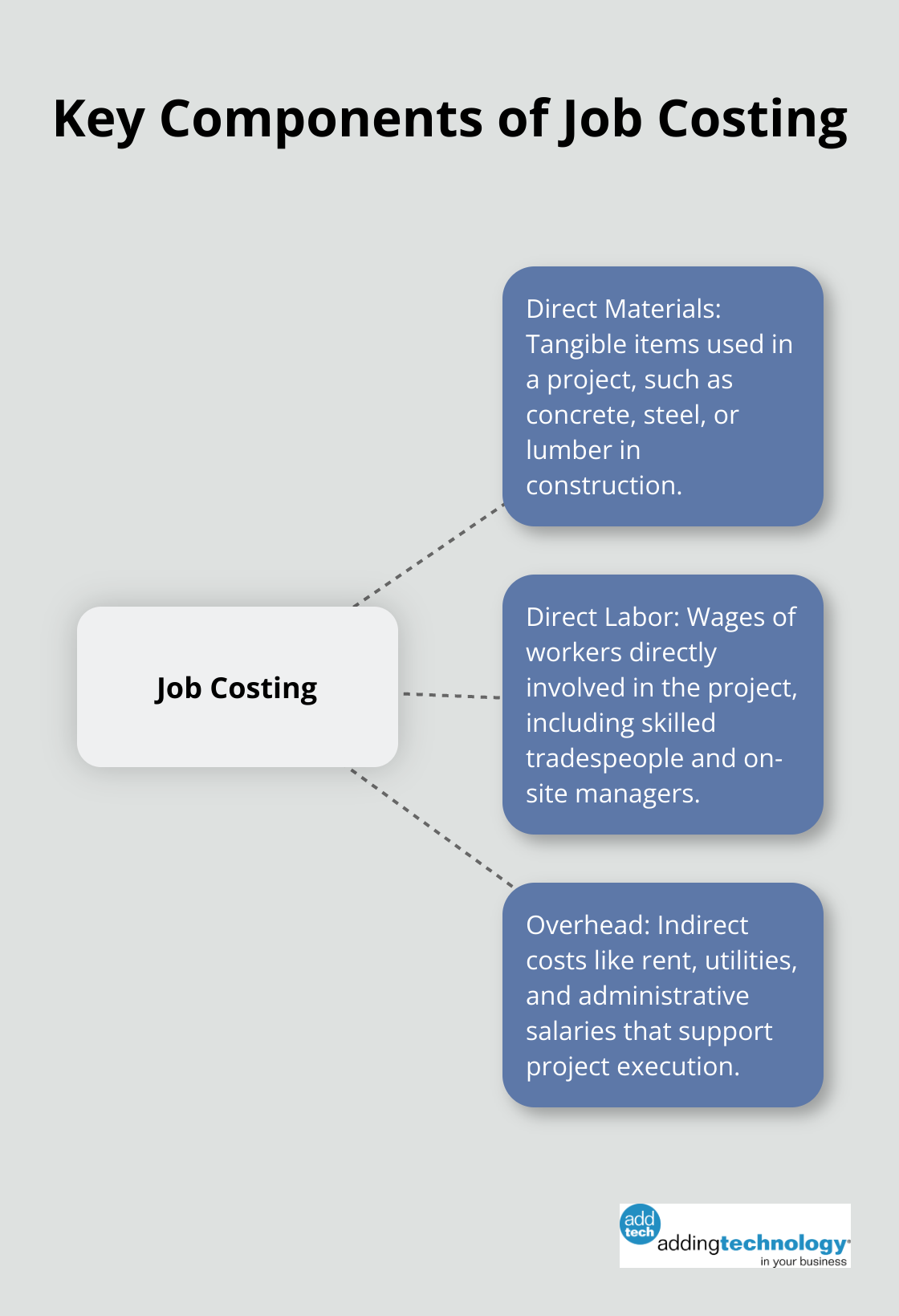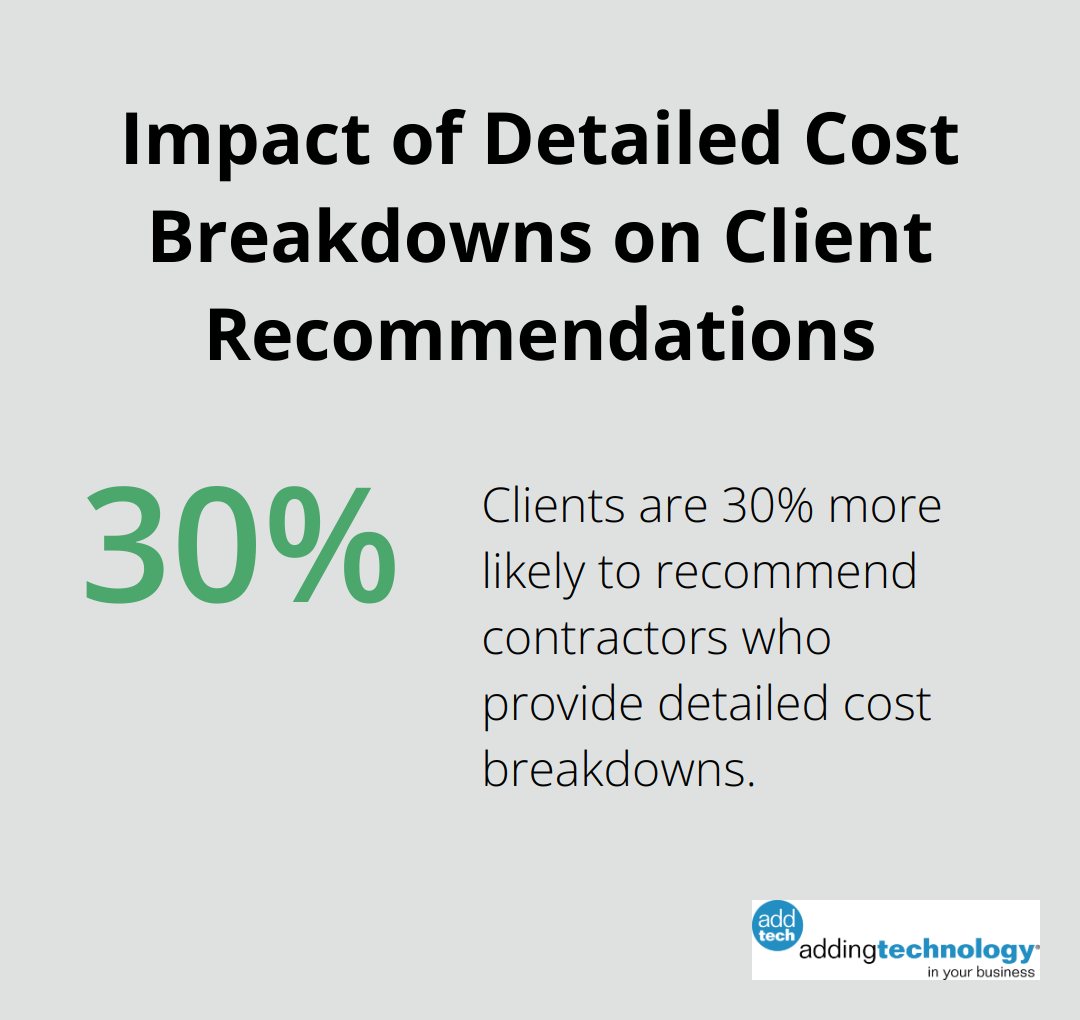
At Adding Technology, we understand the importance of accurate financial management in construction projects. The job costing method is a powerful tool that can revolutionize how construction companies track and analyze their expenses.
This blog post will explore the ins and outs of job costing, its benefits for construction businesses, and practical tips for implementation. We’ll show you how this method can boost your profitability and decision-making processes.
Job costing is a method that tracks and allocates costs to specific projects or jobs. It serves as a vital tool for businesses that handle unique, non-repetitive work. This method meticulously tracks all expenses related to a particular project, including materials, labor, and overhead costs. For instance, in a home renovation project, job costing would track the cost of lumber, the hours worked by carpenters, and a portion of the company’s utility bills.
While construction stands out as a prime example, job costing extends its benefits beyond this sector. Manufacturing (particularly for custom products), service-based industries (like advertising agencies and law firms), and even healthcare providers (for complex medical procedures) all utilize this method effectively.

Job costing processes can be analyzed to determine profitability when applied appropriately to current and previous contracts.
Job costing software allows businesses to allocate costs to specific jobs or projects, giving them a comprehensive view of their operations and financials.
Job costing transcends mere cost tracking-it provides actionable insights. Understanding the true cost of each project empowers businesses to make informed decisions about pricing, resource allocation, and future bids. It serves as a powerful tool for driving profitability and growth in project-based industries.
As we move forward, we’ll explore how job costing specifically benefits construction companies, providing a clear picture of its practical applications in this industry.
Job costing transforms financial management for construction companies. This method allows firms to price projects with razor-sharp accuracy. By tracking costs for each project separately, companies identify the true expenses associated with different types of jobs. This granular view leads to more competitive and profitable pricing strategies. The Construction Financial Management Association emphasizes the importance of a job cost system in calculating earned revenue and improving financial management for construction companies.
One of the most powerful benefits of job costing is its ability to highlight areas where profits slip away. For example, a mid-sized construction firm in Texas discovered through job costing that their electrical subcontractor costs were consistently 15% higher than estimated. This insight led to renegotiations and a 10% increase in overall project profitability.
Job costing provides a wealth of data that informs smarter business decisions. Construction managers use this information to optimize resource allocation, improve scheduling, and identify the most profitable types of projects to pursue. A survey by Sage found that many construction firms rely on outdated or generic accounting systems with limited job costing capabilities, highlighting the need for more advanced solutions.
Transparency in costs builds trust with clients. Job costing allows construction companies to provide detailed breakdowns of expenses, justifying costs and demonstrating value. This level of openness leads to stronger, long-term client relationships. In fact, a client satisfaction survey (conducted by Procore) showed that clients were 30% more likely to recommend contractors who provided detailed cost breakdowns.

With job costing, construction companies monitor the financial health of each project in real-time. This allows for quick adjustments if a project starts to veer off budget. The ability to course-correct mid-project can be the difference between a profitable job and a loss-making one.
Job costing is more than just a financial tool – it’s a strategic asset that propels construction companies to new heights of efficiency and profitability. Now, let’s explore the practical steps for implementing job costing in your construction business, ensuring you harness its full potential.
Start by creating a unique code for each project. This code will serve as the backbone of your job costing system, enabling you to track all associated costs. Next, establish cost codes: Create a standardized system for categorizing and tracking expenses across all projects. Typical categories include direct materials, direct labor, and overhead costs.
Research from IBIS World states that the average net profit margin for construction businesses ranges from 3% to 7%, highlighting the importance of a well-structured framework for maximizing profitability.

Accurate tracking of direct costs is essential. For materials, implement a purchase order system that links each order to a specific job code. This allows for real-time tracking of material costs per project.
For labor, use time tracking software that enables workers to log hours against specific job codes. Many construction companies find success with mobile apps that allow workers to clock in and out on-site (reducing errors and improving accuracy).
Overhead allocation often proves the most challenging part of job costing. A common method involves calculating an overhead rate based on direct labor hours. For example, if your annual overhead is $500,000 and you expect 25,000 direct labor hours, your overhead rate would be $20 per labor hour.
Apply this rate to each job based on the hours worked. However, review and adjust this rate regularly to ensure it accurately reflects your business operations.
Modern job costing software can automate much of this process, reducing errors and saving time. Look for software that integrates with your existing systems and offers real-time reporting capabilities.
Sage Intacct project costing and billing software cuts revenue leakage through an integrated process spanning sales, finance, and operations. This underscores the significant impact technology can have on your bottom line.
While many options are available, Adding Technology specializes in implementing and optimizing job costing systems for construction businesses. Our tailored solutions ensure you get the most out of your job costing efforts.
One frequent challenge is resistance from employees who view detailed cost tracking as burdensome. Address this by clearly communicating the benefits and providing thorough training. Show how accurate job costing can lead to better project management and potentially higher profits, which can benefit everyone in the company.
Another challenge is maintaining consistency across projects. Develop standardized procedures and conduct regular audits to ensure all team members follow the established job costing protocols.
The job costing method revolutionizes financial management in the construction industry. It empowers companies to track costs precisely, price projects accurately, and make data-driven decisions that boost profitability. Construction firms can identify profit leaks, optimize resource allocation, and enhance client relationships through transparent cost breakdowns.
Implementing an effective job costing system requires a structured framework, meticulous cost tracking, and often specialized software. Adding Technology can help transform your financial management processes with tailored job costing systems for construction businesses. We specialize in renovating accounting systems, implementing real-time job costing, and integrating advanced technology solutions.
The construction industry continues to evolve, and so should your financial management practices. Embrace the job costing method, leverage technology, and partner with experts who understand your industry’s unique challenges. Your future projects will benefit from this solid financial foundation.









At adding technology, we know you want to focus on what you do best as a contractor. In order to do that, you need a proactive back office crew who has financial expertise in your industry.
The problem is that managing and understanding key financial compliance details for your business is a distraction when you want to spend your time focused on building your business (and our collective future).
We understand that there is an art to what contractors do, and financial worries can disrupt the creative process and quality of work. We know that many contractors struggle with messy books, lack of realtime financial visibility, and the stress of compliance issues. These challenges can lead to frustration, overwhelm, and fear that distracts from their core business.
That's where we come in. We're not just accountants; we're part of your crew. We renovate your books, implement cutting-edge technology, and provide you with the real-time job costing and financial insights you need to make informed decisions. Our services are designed to give you peace of mind, allowing you to focus on what you do best - creating and building.
Here’s how we do it:
Schedule a conversation today, and in the meantime, download the Contractor’s Blueprint for Financial Success: A Step by-Step Guide to Maximizing Profits in Construction.” So you can stop worrying about accounting, technology, and compliance details and be free to hammer out success in the field.